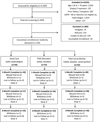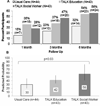Effectiveness of educational and social worker interventions to activate patients' discussion and pursuit of preemptive living donor kidney transplantation: a randomized controlled trial
- PMID: 23089512
- PMCID: PMC3710736
- DOI: 10.1053/j.ajkd.2012.08.039
Effectiveness of educational and social worker interventions to activate patients' discussion and pursuit of preemptive living donor kidney transplantation: a randomized controlled trial
Abstract
Background: Many patients with chronic kidney disease (CKD) have difficulty becoming actively engaged in the pursuit of preemptive living donor kidney transplantation.
Study design: The Talking About Live Kidney Donation (TALK) Study was a randomized controlled trial of the effectiveness of educational and social worker interventions designed to encourage early discussions and active pursuit of preemptive living donor kidney transplantation in patients with progressive CKD.
Setting & participants: We recruited participants with progressive CKD from academically affiliated nephrology practices in Baltimore, MD.
Intervention: Participants randomly received: (1) usual care (routine care with their nephrologists), the (2) TALK education intervention (video and booklet), or the (3) TALK social worker intervention (video and booklet plus patient and family social worker visits).
Outcomes: We followed participants for 6 months to assess their self-reported achievement of behaviors reflecting their discussions about and/or pursuit of living donor kidney transplantation (discussions with family, discussions with physicians, initiating recipient evaluation, completing recipient evaluation, and identifying a potential living donor).
Measurements: We assessed outcomes through a questionnaire at 1-, 3-, and 6-months follow-up.
Results: Participants receiving usual care with their nephrologists (n = 44), TALK education (n = 43), and the TALK social worker (n = 43) were similar at baseline. TALK Study interventions improved participants' living donor kidney transplantation discussion and pursuit behaviors, with the social worker leading to greater patient activation (participants' predicted probability of achieving living donor kidney transplantation discussions, evaluations, or donor identification over 6 months): probabilities were 30% (95% CI, 20%-46%), 42% (95% CI, 33%-54%), and 58% (95% CI, 41%-83%), respectively, in the usual care, TALK education, and TALK social worker groups (P = 0.03).
Limitations: Our population was well educated and mostly insured, potentially limiting generalizability of our findings.
Conclusions: TALK interventions improved discussion and active pursuit of living donor kidney transplantation in patients with progressive CKD and may improve their use of preemptive living donor kidney transplantation.
Trial registration: ClinicalTrials.gov NCT00932334.
Copyright © 2013 National Kidney Foundation, Inc. Published by Elsevier Inc. All rights reserved.
Figures


Comment in
-
Getting more people TALKing about kidney transplantation.Am J Kidney Dis. 2013 Mar;61(3):368-70. doi: 10.1053/j.ajkd.2013.01.003. Am J Kidney Dis. 2013. PMID: 23414730 No abstract available.
References
-
- Terasaki PI, Cecka JM, Gjertson DW, Takemoto S. High survival rates of kidney transplants from spousal and living unrelated donors. N.Engl.J Med. 1995;333(6):333–336. - PubMed
-
- Mange KC, Joffe MM, Feldman HI. Effect of the use or nonuse of long-term dialysis on the subsequent survival of renal transplants from living donors. N.Engl.J Med. 2001;344(10):726–731. - PubMed
-
- Gore JL, Danovitch GM, Litwin MS, Pham PTT, Singer JS. Disparities in the Utilization of Live Donor Renal Transplantation. American Journal of Transplantation. 2009;9(5):1124–1133. - PubMed
-
- Kasiske BL, Snyder JJ, Matas AJ, Ellison MD, Gill JS, Kausz AT. Preemptive kidney transplantation: the advantage and the advantaged. J Am Soc Nephrol. 2002 May;13(5):1358–1364. - PubMed
-
- Finkelstein FO, Story K, Firanek C, et al. Perceived knowledge among patients cared for by nephrologists about chronic kidney disease and end-stage renal disease therapies. Kidney Int. 2008 Nov;74(9):1178–1184. - PubMed
Publication types
MeSH terms
Associated data
Grants and funding
LinkOut - more resources
Full Text Sources
Other Literature Sources
Medical

